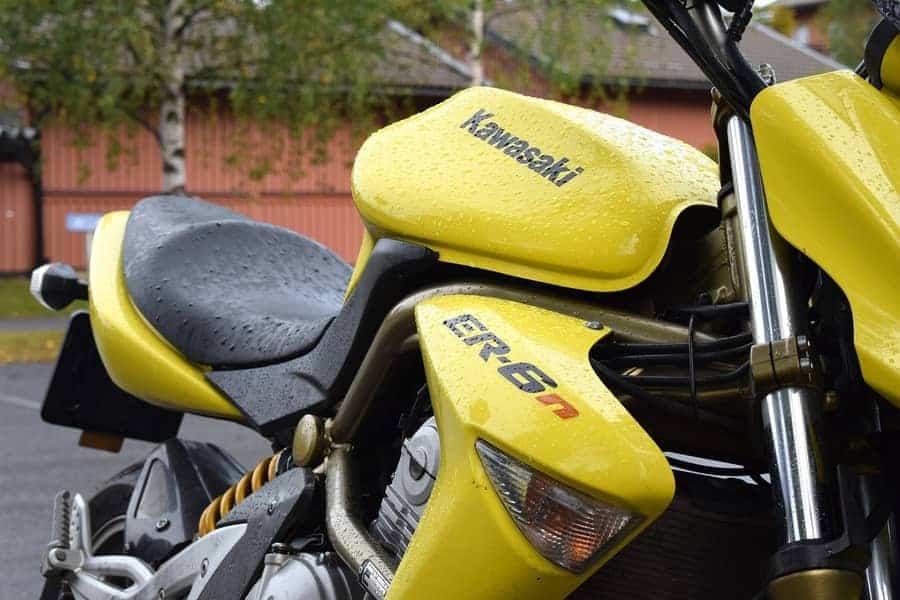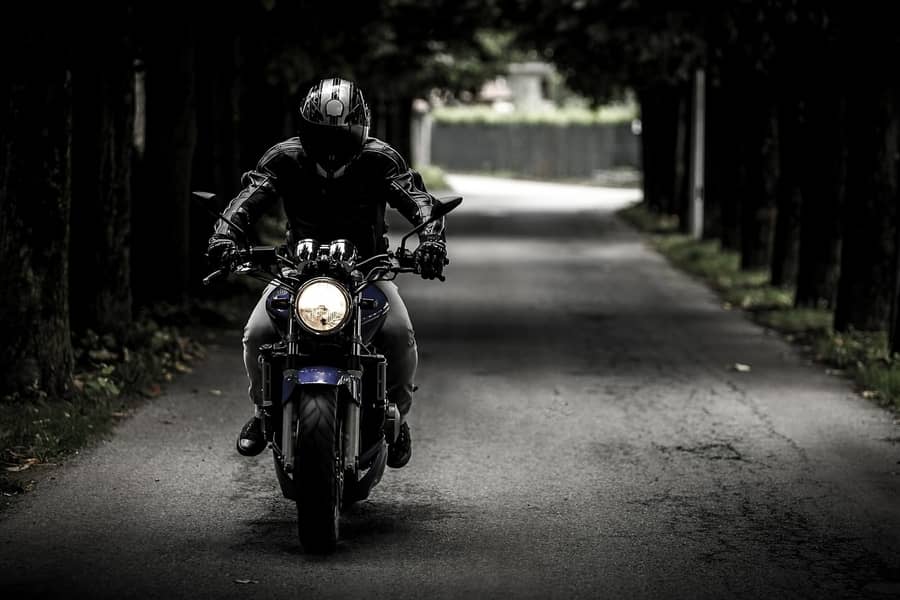
As a motorcycle lover and owner, there’s nothing that gives me more joy and satisfaction than seeing my baby shine. Especially after a long day of moving around on all kinds of terrain, the only spa treatment a motorcycle can receive is a good wash.
But how exactly do you go about cleaning a motorcycle? I’ll give a quick summary, followed by an in-depth description. Follow these steps to clean your motorcycle properly:
- Let the bike cool down
- Rinse the motorcycle
- Clean the chain
- Clean non-chrome engine components
- Wash the body
- Dry your motorcycle
- Buff the bike
- Wax the motorcycle
I take good care of my bike since it is an integral part of my life. When cleaning it, there are certain precautions that I take to ensure no damage occurs. Just like any other machinery, a motorcycle needs careful handling. That aside, the process isn’t hard, and it is something you will actually enjoy. One thing that I’ve noticed during my regular clean-ups is that you can discover a lot of mishaps and actually fix them right away.
What You’ll Need
There are a bunch of items I use when cleaning my motorcycle. Most of them are vital in the process and come in handy at different stages. You should definitely get your hands on all of them if you hope to get yourself a glowing bike by the end of the wash. These are the items I use, which I strongly recommend for any serious bike lover:
- Brush, i.e. old toothbrush
- Sponge
- Rags
- Microfiber cloth
- Chain lube
- Hose with adjustable nozzle
- Motorcycle cleaner (should be specific)
- Bucket
- Degreaser
- Motorcycle wax
- Tar remover (If needed at the time)
The materials above work hand in hand during the cleaning process. For instance, I use sponges to remove grime that sticks on the motorcycle, brushes for wheels or hard to reach areas, clothes for the drying process and microfiber for final touches. You can learn how I use the rest of the materials as you progress in the article.
Preparation
Cleaning a motorcycle is just like pulling off a stunt: you need lots of space to do that successfully. It wouldn’t be ideal or exactly comfortable cleaning your bike in a tight corner. Ideally, you should find a spacious, well-shaded area, in order to prevent the lather from drying off while you’re still washing.
After getting yourself the right spot, take all the items that I stated above and set them at strategic positions. You don’t want to start cleaning and realize that you don’t have a brush with you when you need it. This used to be a big hitch for me since I’d always start washing and then leave my cleaning to start roaming about, searching for either the brush or something else. It’s best you get everything set before you start washing.
Next, you will need to get your baby ready for the wash. In essence, when getting your bike ready, picture a temperamental toddler who’s about getting a bath. Just like the toddler, your motorcycle needs to be pampered and prepared well before cleaning. One big mistake most bike owners make while cleaning is to wash while the engine is still hot, and that’s the ideal ingredient for thermal shock. Personally, I give my bike some time to cool off before cleaning. You can always check the temperature by touching the exhaust. But be careful since you might burn yourself.
When preparing your motorcycle, there are sensitive areas that you need to take care of first – the exhaust hole being first in this case. Generally, bikes are made to endure splashes of water since you will be riding it outdoors. But it won’t cost you a thing to cover the exhaust holes with rubber plugs during cleaning. This prevents splashes and droplets of water getting in and spoiling a thing or two. You don’t even have to use a rubber plug as you can use a rag or glove.
As mentioned earlier, a safety precaution I’ve been taking whenever I’m cleaning my motorcycle is simply carrying out a thorough inspection first. This will help you identify any issues that would get worse once you pour water on the bike. As a matter of fact, I’ve made it a tradition to check all the electrical components, wires, spark plug, and other vital components, to make sure that everything is in order before I start cleaning. You definitely won’t like getting an electric shock.
Step by Step Washing Process
Now, we’re going on to the real thing – getting your bike washed. The following is a step by step guide which will get you a well-cleaned bike, should you follow exactly what I’ve written here.

1. Rinse the motorcycle
For you to avoid any traces of particles left on the surface of your bike, you need to start the cleaning process with a gentle rinse, using a mixture of the motorcycle cleaner and water. This must be done before you proceed with any other process. This also helps to remove some gunk on the surface, making the clean-up smoother and more manageable.
NOTE: Always make sure your bike is properly cooled now. Washing your bike whiles being hot, may cause damage to your engine!
2. Clean the chain
The chain is an integral part of any motorcycle. It is the system that drives the back wheel thus enabling the bike to move forward. This is why it needs to be cleaned regularly, in order to ensure that your rides give you the thrill you expect. In most cases, I use a degreaser to get rid of unnecessary grease on the chain. And cleaning the chain early during your wash is quite a brilliant move since it prevents the grime from splashing all over the motorcycle during the process.
NOTE: You will still need to apply lubricant to your chain once you are through with cleaning the motorcycle. Here you can use certified chain lube.

3. Clean non-chrome engine components/areas
After you are done with the chain, you can now go for the engine. Remember that starting with the most important parts is better in this process. Often there are various spots on the engine that need special care and it’s best to focus on them at first. This is where I use the brushes; personally, I make do with an old toothbrush but you can head over to the mall and see if you find something else that suits you better. Brushes usually get to hard-to-reach areas more easily than clothes. With the brush, you can dip it in cool water and then scrub off the dirt gently. This gets rid of any unwanted debris on the engine making it shine just like the bike will once you’re done washing.
NOTE: Keep off the bearings and brake linings as any water that gets into such areas can lead to severe corrosion and damage.
4. Wash the body
In my opinion, this is the most demanding part of washing a bike. It takes more time and requires more energy – although it’s not more than you can handle in an afternoon. To make the process quite easy, I usually start with a spray cleaner which is useful for loosening bugs, mucks and other remnants left on the bike after riding. The next step is to rub the whole body of the bike with a soft sponge or cloth. You can do this by dipping the sponge or fabric in a bucket of water and wiping all over the body.
When cleaning the body, start from the top and continue towards the lower parts of the bike. You should also be careful not to use inappropriate tools or chemicals on your motorcycle as this can lead to corrosion. Of course, having ridden the bike, you would expect the sponge or cloth to regularly pick up grease, grime or just any type of dirt. When this happens, you should clean it first or swap it before going on to the rest of the body. Another thing I do is to change the water bucket regularly during cleaning to avoid using dirty water. Using water that has grease and grime in it takes up much more time than is actually required.
NOTE: In case you are cleaning your bike during winter to remove salt residue, you can use just water instead of combining other cleaners or detergents. After that, you can wax it using motorcycle wax.
When cleaning plastic parts, use slightly soapy water or other cleaning solutions. This helps to give it that sparkling look after you are done. It is vital that you use approved soap and cleaning liquids so that you can avoid any form of corrosion for your plastic parts. This also helps you avoid any damage to your hands, resulting from overly acidic or alkaline chemicals.
After you are done with all that, you can rinse the motorcycle once again. I usually do this immediately to prevent soap foam from sticking on the surface of my bike. When you allow detergent to dry on the surface of the bike, you will have a hard time getting rid of swirls and streaks that are found on the surface. In this stage, you need to be thorough with the rinsing as you want to remove all residues on the surface and leave the motorcycle sparkling. You can spray the water from all angles so that you’re sure every part is thoroughly washed. Here I recommend using a hosepipe instead of a bucket due to the pressure difference since you need pressurized water to get a better wash.
You can also get a gentle spray which you will use to wash away any pending dirt and suds. If there isn’t much residue left on the surface, you can use a clean sponge, dipped in water, to clean the motorcycle.

5. Drying the motorcycle
After you have rinsed the bike thoroughly, you now need to wipe it so that you can avoid those icky water spots which tend to remain on the surface if not wiped off. This is where I use a microfiber cloth and gently rub my motorcycle. The need to wipe your bike immediately is not just to avoid the said water spots alone. In addition to these annoying spots, water that has been left on the bike can cause corrosion to parts. This is why you need to take this particular process very seriously.
Another alternative to using a microfiber cloth is utilizing an air blower. This reduces the chances of you placing your hands on the parts during drying. It also saves on time and energy used in the process.
One funny method I often see people using to dry their motorcycles involves riding. Yes, some people prefer taking their babies for a ride so that the water can splash off while they’re zooming at breakneck speed. Not bad, but not the very best option. In my opinion, I view this method as inconvenient since some of the parts stay wet. Also, you would need to ride the bike for a long time so that the engine gets warm enough to dry, which is fun anyway but a more tiring and time-consuming procedure.
One other practice that I see some people doing, which I strongly advise against, is leaving the motorcycle to dry in sunlight. As much as this is a more natural way requiring less energy, it’s not ideal. “Why?” you ask? Sunlight will dry your motorcycle alright, but will leave on some ugly spots of water. And you definitely don’t want to do a great job and then end up with that, do you?
6. Buff the motorcycle
Buffing is done to get a better finished look once you’re done. This is focused on the seats which are made from various materials, depending on the model you own. In most cases, the seats are made from leather or vinyl. Vinyl seats are considered stable and tough but can wear out, crack or fade over time. On the other hand, leather seats are quite delicate to handle.
For the vinyl material, you can use an approved protectant while for leather seats, you may use leather care cream. You can get these items at any motorcycle store around you. Also, using detergent on leather is a complete no-no. It’s going to be too harsh on your seat and will wear it out in no time.
7. Wax the motorcycle
The final procedure in the cleaning process is waxing. By the time you begin this procedure, your bike is already clean. Think of it as keeping your motorcycle clean for longer, after spending long time cleaning. I’m guessing polishing and waxing a motorcycle should be the subject of an entire article here, I’ll cover the basics of what you need to know about waxing and polishing your bike.
Waxing isn’t a brief, easy procedure and it takes quite a bit of time for you to be done with. Wax is useful in making the surface of your already clean bike have that glistening goodness. Besides, it also prevents the paint from corroding quickly. There are several motorcycle waxes that you can use for this process, and they can easily be found in specialist motorcycle stores.
Avoid polishing as this would be cutting away layers on your cleaned motorcycle and leaving it with a bad look on the surface. And if you’re still itching for some more info about waxing, you can rest easy. That will follow in our next few articles and all you need to do is to keep following for our updates.

Summary: Lessons Learned
As you probably know already, there are a thousand and one different ways to kill a rat. These are my ways of “killing the rat.” Now, I know a bunch of motorcyclists out there may have their own specialized ways of getting their bikes clean and I have nothing against them or their own ways of getting their bikes sparkling. In fact, there are many ways to get the job done, but what you have above is the best you can find and put to your use. Also, these are quite easy steps to follow and won’t give you so much trouble. Now, here are two takeaway lessons I’d like to pass on to you – lessons over several years of cleaning numerous motorcycle:
- Always, did I say always? Yes, I repeat, always take precautions seriously. When you see a warning anywhere, make sure that you do not ignore. Sometimes you might overlook it, thinking it’s not all too essential. And guess what? Most times, that will only end you up regretting. Don’t be that guy who does the regretting.
- Following instructions is important. I didn’t take time to put this article together just because I felt like lecturing you on what to do. It is here to help you get the job done right. All I’m emphasizing is that you should try as much as possible to follow every instruction and take them seriously.
Now I hope your bike will shine like when it was new, until you have to wash it again. And till then, have fun – get out there and just ride!
